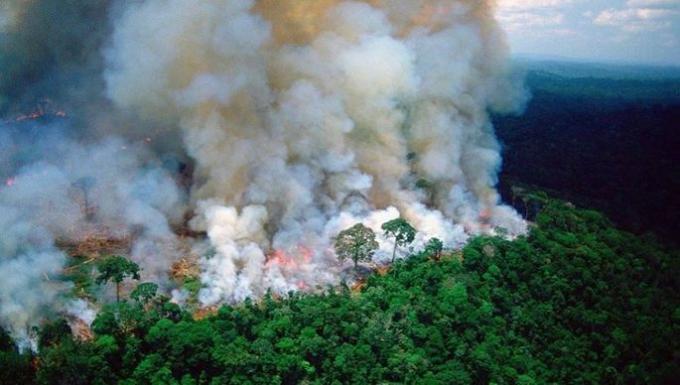Fake news is false news disseminated with the intention of inciting people to have certain behaviors - influencing decisions, causing revolt, among others. Most of the time they are shared on social media.
For this reason, they address current events that are under discussion. Thus, whoever reads this type of news is led to believe what is written in it, especially if the news deals with a theme favorable to the reader's beliefs or, even, if you do not have a formed position about a certain subject matter.
The feeling that other people also need to know about that fact lead to its disclosure, which, however, is done without confirming its veracity.
How did fake news come about?
The fake news concept became popular in 2016, at the time of the campaign for the presidency of the United States of America (USA), when Donald Trump was a candidate.
The fake news in the US elections targeted regions where the Democratic and Republican strands did not dominate, that is, people who had doubts about the choice of candidates. Doubt is often a motivator for the rapid spread of false news and that's what happened.
Such news would not work so well in regions where people already had an opinion on the candidates. The objective was precisely to reach people who were not convinced about their vote and thus influence their choice.
Despite the dimensions that the spreading of false news took on the occasion of the 2016 US elections, the spread of incorrect and misleading facts has been going on for longer.
With the advent of social networks and the consequent ease of reaching thousands of people at once, fake news has gained great proportions.
That's because people have a great need to share content, which usually happens for two reasons: or because they want to be the first to disclose information that will cause scandal, or to show themselves increasingly present in the networks.
Thus, many publish content simply for publishing, without first worrying about attesting to the quality of the information.
Examples of fake news
Fires in the Amazon in 2019
In 2019, fires in the Amazon were the target of fake news. In addition to information written with incorrect data, many outdated images - or from other places - have also strengthened the spread of false news.
The inexistence of NGOs in the Northeast versus the existence of 100,000 NGOs in Amazonas, in addition to the fact that 2019 registers the biggest fire in the territory of the Legal Amazon was the false information that circulated the most on social networks.
The dissemination of old photos is another example of fake news in this event. The photo below was published at the time of the 2019 fires, but it was taken many years earlier. Its author, photographer Loren McIntyre, passed away in 2003 and this photo is available on the British Alamy Image Bank.

Vaccines and other health news
False warnings and recommendations have been very common with regard to health. Vaccines have been one of the hottest topics in false news.
In São Vicente-SP, the news that the flu vaccine caused a “hole” in the arm caused more doubts among the population. More and more people are afraid of being vaccinated because there is a lot of content alleging harm from vaccines being divulged.

Cause of multiple sclerosis and development of lupus as a result of the use of aspartame was another message that went viral. As the use of sweeteners is controversial, people are even more questioning whether it is safe to consume them or not.

How does fake news work?
Because of the interests around fake news, they involve a lot of money and skills.
For false news to achieve the desired effect, there are specialized teams working on its creation. Since there are people willing to pay a lot to benefit from misleading news, the creators of fake content earn very well.
Thus, the production of false news can involve a large apparatus: people in the communication field, who write the news, and people in the technology field, who work behind the scenes; these ensure that trails of misleading news go undiscovered.
In addition to these supposed professionals, they can be hired as producers of fake news or voice actors who imitate people's voices.
Fake content producers have their tricks not to be found. Uses of servers abroad, use of LAN houses and purchases of cell phone numbers, for which payments are made with prepaid cards, are just some of their precautions.
Depending on the size of the service for which they are hired, those responsible for creating fake news may have to travel frequently. In these cases, they do not stay in the same accommodation for long.
Messages of fake content can be transmitted through purchased phone numbers, as well as through fake profiles created by professionals on social media.
With an apparently normal appearance, the profiles have photos, publications and, thus, interaction with other people begins, who are asked to share the news.
In addition to creating fake profiles, sites are also created that are visually similar to well-known sites, and until it catches users' attention, the content is not controversial. From a certain point, these sites start to spread false news, which becomes more and more frequent.
Dangers of fake news
In the past, people complained about lack of information. We currently have access to a lot of information and it is very easy to propagate any content, whether it is credible or not. Thus, the problem became the lack of guarantee about the veracity of the things shared.
Spreading false news can do serious harm. Some consequences of fake news are:
- Manipulation of people;
- Moral and financial damage to people and companies;
- Wrong decision making;
- Creating or increasing a feeling of revolt;
- Behavior change;
- Stimulus to prejudice;
- Aggravation of disease outbreak.
How to fight fake news?
Fake news is an increasingly sophisticated and complex crime, which makes its investigation difficult. Furthermore, the legislation, in addition to being inconsistent, does not specifically provide for punishment for this type of crime.
It is important that all citizens are aware of their responsibility in fighting the news false and that understand that we should not share all the content received, especially if it looks like doubtful.
So, be aware of the signs that the fake news texts present:
- Spelling errors;
- Outdated information;
- Appealing: requests for sharing by people;
- Alarmists.
If after posting something, you discover that the news is false, delete the content or deny the information to the friends you shared it with.
However, there are agencies that specialize in investigative journalism. This is the case of Agência Lupa, Aos Fatos and Boatos.org, agencies that check the contents as to their veracity. People can turn to them if they suspect dubious content posted on the net.
You may also be interested in:
- Social networks: what are they and what are they for?
- What is Cyberbullying?


